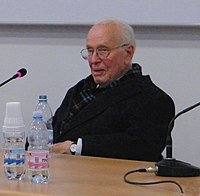
Photo from wikipedia
Birth-death stochastic processes are the foundation of many phylogenetic models and are widely used to make inferences about epidemiological and macroevolutionary dynamics. There are a large number of birth-death model… Click to show full abstract
Birth-death stochastic processes are the foundation of many phylogenetic models and are widely used to make inferences about epidemiological and macroevolutionary dynamics. There are a large number of birth-death model variants that have been developed; these impose different assumptions about the temporal dynamics of the parameters and about the sampling process. As each of these variants was individually derived, it has been difficult to understand the relationships between them as well as their precise biological and mathematical assumptions. Without a common mathematical foundation, deriving new models is non-trivial. Here we unify these models into a single framework, prove that many previously developed epidemiological and macroevolutionary models are all special cases of a more general model, and illustrate the connections between these variants. This unification includes both models where the process is the same for all lineages and those in which it varies across types. We also outline a straightforward procedure for deriving likelihood functions for arbitrarily complex birth-death(-sampling) models that will hopefully allow researchers to explore a wider array of scenarios than was previously possible. By re-deriving existing single-type birth-death sampling models we clarify and synthesize the range of explicit and implicit assumptions made by these models.
Journal Title: Systematic biology
Year Published: 2021
Link to full text (if available)
Share on Social Media: Sign Up to like & get
recommendations!